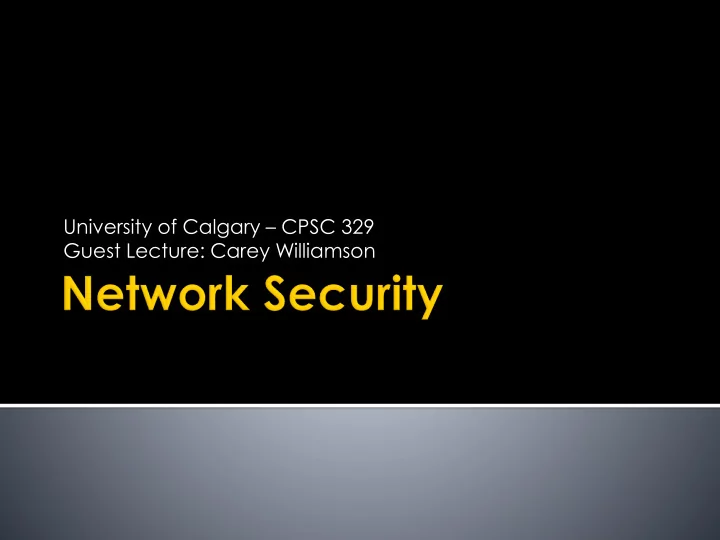

University of Calgary – CPSC 329 Guest Lecture: Carey Williamson
What is “network security”? Types of attacks Real-world examples Wrapup and questions 2
The field of network security is about: ▪ how the “bad guys” attack computer networks (or users) ▪ how the “good guys” defend networks against attacks ▪ how to design architectures that are immune to attacks Note that the Internet was not originally designed with (much) security in mind… ▪ original vision: “a group of mutually trusting users attached to a transparent network” ☺ ▪ Internet protocol designers have been playing “catch - up” by trying to add security features to existing protocols ▪ Security considerations are needed in all protocol layers! 3
Packet sniffing (to steal confidential personal information) Spoofing (to forge identity, location, or other credentials) Playback (to record and replay valid credentials later) Scanning (to actively probe for vulnerable hosts or ports) Malware (malicious software, to exploit vulnerabilities) DoS: Denial of Service (to make a service inaccessibly slow) DDoS: Distributed DoS (like DoS on steroids, using botnets) Inference attacks (to learn implicit structural information) 4
The bad guys can observe packets on a LAN ▪ shared broadcast media (classic Ethernet, WiFi hotspots) ▪ promiscuous network interface can read and record the contents (including passwords!) of all transmitted packets C A src:B dest:A payload B Wireshark software is an example of a “packet sniffer” 5
• The bad guys can use false source addresses • IP spoofing: send packet with false source address C A src:B dest:A payload B 6
• The bad guys can record/playback packets • sniff sensitive info (e.g., password), and use later • password holder is the legit user from system point of view C A src:B dest:A user: B; password: fooz B 7
Malware can get in host from a virus, worm, or trojan horse. Spyware malware can record keystrokes, web sites visited, upload info to collection site. Infected host can be enrolled in a botnet, used for spam and DDoS attacks. Malware is often self-replicating: from an infected host, seeks entry into other hosts 8
Trojan horse Worm: ▪ infection by passively ▪ Hidden part of some receiving object that otherwise useful software gets itself executed ▪ Today often on a Web ▪ self- replicating: page (Active-X, plugin) propagates to other hosts, users Virus ▪ infection by receiving object (e.g., e-mail attachment), actively executing ▪ self-replicating: propagate itself to other hosts, users 9
Bad guys can attack servers and network infrastructure ▪ Denial of service (DoS): attackers make resources (server, bandwidth) unavailable to legitimate traffic by overwhelming resource with bogus traffic 1. select target 2. break into hosts around the network to create a “ botnet ” target 3. send packets toward target from compromised hosts 10
As a networking researcher, I have seen many strange and mysterious things on the U of C network, including these: Port scanning NTP amplification attacks RIP attacks Viruses/malware SSH attacks DoS attacks Spam bots 11
12
13
Outbound Traffic Totals for February 2016 # IP Name Protocol Port Service Volume Issue? 1 518.90 UDP 123 NTP 9.8 TB Yes 2 334.148 rb1-s UDP 53 DNS 6.5 TB 3 334.130 rb1 UDP 53 DNS 2.9 TB 4 649.196 gvpn TCP 10433 VPN 2.9 TB 5 951.98 aurora TCP 80 HTTP 2.8 TB 6 742.7 ns4-a UDP 53 DNS 2.3 TB 7 742.5 ns2-a UDP 53 DNS 2.1 TB 8 906.25 www TCP 80 HTTP 1.7 TB 9 819.141 TCP 443 HTTPS 1.5 TB Maybe 10 742.6 ns3-a UDP 53 DNS 1.5 TB 14
Connection Counts for January 2016 # IP Name Protocol Port Service Conns Issue? 1 293.8 pc8 UDP 665 908 M Yes 2 293.9 pc9 UDP 665 778 M Yes 3 293.7 pc7 UDP 665 702 M Yes 4 293.8 pc8 UDP 655 538 M Yes 5 293.9 pc9 UDP 655 502 M Yes 6 529.230 pc230 UDP 137 NetBios 476 M Yes 7 293.7 pc7 UDP 655 469 M Yes 8 518.90 UDP 123 NTP 324 M Yes 9 334.148 rb1-s UDP 53 DNS 261 M Maybe 10 334.51 nassrv3 UDP 520 RIP 240 M Maybe 15
Spambot-generated email traffic (mostly) Human-generated email traffic (mostly)
Jan 25 Mar 4 Mar 11 (noon) (4am) (6pm) Jan 28 (6-9pm) March 28 Jan 21 (noon) 17
Take CPSC 441: Computer Networks ▪ Learn about the Internet and its protocol stack Take CPSC 526: Network Systems Security ▪ Course Description: “Attacks on networked systems, tools and techniques for detection and protection against attacks including firewalls and intrusion detection and protection systems, authentication and identification in distributed systems, cryptographic protocols for IP networks, security protocols for emerging networks and technologies, privacy enhancing communication. Legal and ethical issues will be introduced.” 18
Some of these slides are courtesy of: Computer Networking: A Top Down Approach 6 th edition Jim Kurose, Keith Ross Addison-Wesley March 2012 19
Recommend
More recommend